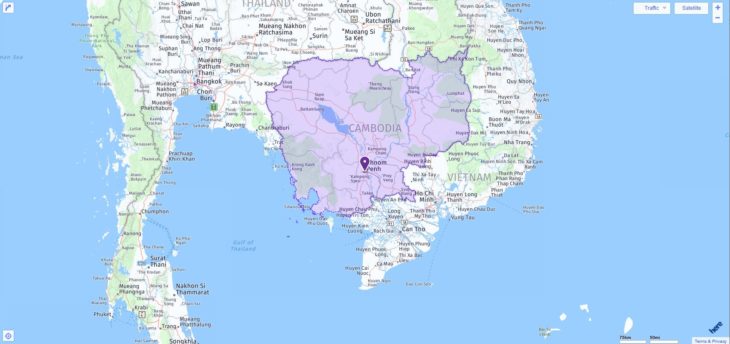Your search found 2 matches. The following is the full list of ACT testing locations in Cambodia among which you can pick one to take the exam. Please know that on the test day, test takers can use any 4-function, scientific, or graphing calculator. On the table below, you can also find all test dates through 2019.

2019-2020 ACT Test Dates in Cambodia
| Test Date | Registration Deadline |
| February 9, 2019 | January 11, 2019 |
| April 13, 2019 | March 8, 2019 |
| June 8, 2019 | May 3, 2019 |
| July 13, 2019 | June 14, 2019 |
| September 14, 2019 | August 16, 2019 |
| October 26, 2019 | September 20, 2019 |
| December 14, 2019 | November 8, 2019 |
| February 8, 2020 | January 10, 2020 |
| April 4, 2020 | February 28, 2020 |
| June 13, 2020 | May 8, 2020 |
| July 18, 2020 | June 19, 2020 |
ACT Test Centers in Cambodia
| City | Center Name | Center Code |
| Phnom Penh | Zaman University | 873180 |
| Puok District | Jay Pritzker Academy | 872840 |
More about Cambodia
Geography
Location
Cambodia is bordered by Thailand to the west and northwest, Laos to the northeast, Vietnam to the east and south, and the Gulf of Thailand to the southwest.
Cambodia’s heartland is formed by the fertile Mekong and Tonle Sap basins.
In the north the Dangrek chain (up to 750 m above sea level) follows the border with Thailand, in the east the foothills of the Annamite Cordillera form the border with Vietnam. In the south-west runs the flat and bay-rich coast of the Gulf of Thailand; in the northern coastal area, the Cardamom Mountains in the Phnom Aural rise to 1,813 m above sea level.
Climate
The climate is tropical and warm and is determined by the southwest monsoon, which brings rainfall of up to 4,000 mm from June to November (1,300–1,800 mm in the central lowlands). At this time, the Mekong swells so much that its waters cannot drain off to the delta quickly enough. They then flow temporarily into the Tonle Sap and back to the delta in the dry season. The dry northeast monsoon blows from November to May. The average annual temperature is 27 ° C (in Phnom Penh).
Vegetation
The rainforest framing the mountains is covered with tropical rainforest. In the drier interior of the country there are (today strongly reduced) deciduous monsoon forests, also floodplain forests and swampy savannas. Mangrove occurs on the coast. A large number of endangered animal species still live in the forest areas.
Population and Religion
Population
Around 90% of the population are Khmer, 5% are Vietnamese who immigrated mainly in the 1980s, 4% Cham and others. Groups of Malay origin, 1% are Chinese and ethnic minorities living in the highlands, e. B. Lao, Choir and Hre. These groups made up about 15% of the population prior to 1975. Between 1975 and 1979, however, they were separated from the rest of the Khmer in cooperatives together with the intellectuals of the Khmer Rouge, forcibly relocated to the northwest to cultivate the rice fields, expelled or killed. In total, an estimated 1.7 million people fell victim to the terror regime.
With 91 residents / km 2, Cambodia is one of the sparsely populated countries. Most of the population lives in the central lowlands. Large parts of the mountains are almost uninhabited. The share of the urban population is (2017) 21%; largest city is the metropolis of Phnom Penh.
The biggest cities in Cambodia
| Biggest Cities (Inh. 2008) | |
| Phnom Penh | 1,243,000 |
| Siem Reap | 168 700 |
| Battambang | 140 500 |
| Poipet | 89 500 |
| Sihanoukville | 89 400 |
Religion
The constitution defines Buddhism as the state religion and, bound by the general legal framework, guarantees non-Buddhist religious communities the right to freely practice their religion. The king is the bearer of the highest decision-making power in the national Buddhist monks’ council (Samgha) and appoints the heads of the two Buddhist orders in the country.
The Hinayana Buddhism (Theravada school), to which almost all Khmer profess with around 95% of the population, has shaped the religious life of Cambodia since its introduction in the 14th century. The Cham and Malays are Sunni Muslims, with few exceptions, whose population is estimated to total about 2.5 to about 4%. The Christians (around 0.26% of the population) belong to the Catholic Church and half of the various Protestant churches and communities (around 20 denominations in total). Other religious minorities are the followers of Caodaism and the “Hoa Hao” (Vietnam, religion). Traditional ethnic religions have survived among the hill tribes.
Education
The educational system, which had previously been based on the French model, had come to a complete standstill during the rule of the Khmer Rouge. Although it has been around since the 1990s BC. a. could be stabilized with international support, it is still considered underdeveloped. The school system is divided into a six-year primary level, for which schooling is compulsory, and a six-year secondary level, which is divided into three-year lower and upper levels. There are several universities and colleges in the higher education sector.

